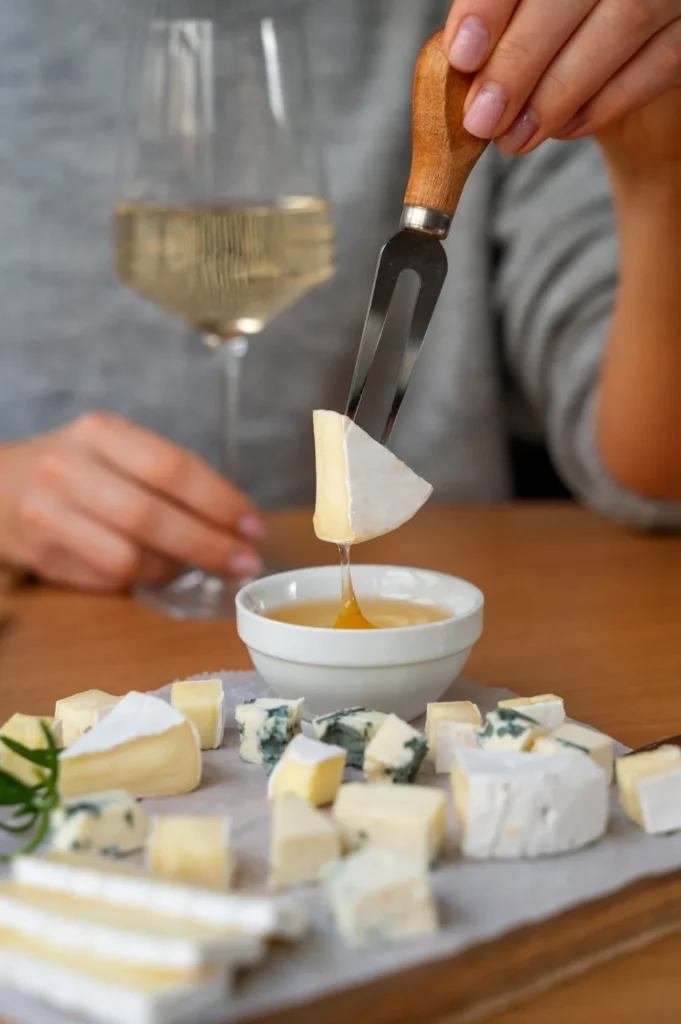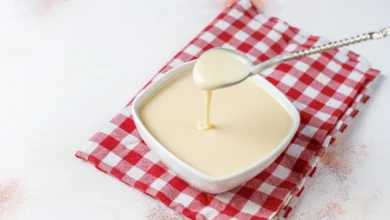What Does Brie Taste Like: A Complete Flavor Guide

Brie cheese offers a taste unlike any other. This French delicacy possesses a rich, buttery flavor profile with subtle hints of earthiness and a gentle sweetness. Its texture is truly unique – creamy and soft, almost melting in your mouth. Brie is a true masterpiece for food enthusiasts worldwide.
Contents
- What does Brie Taste Like?
- What is Brie?
- Different Types of Brie and Their Taste
- Making Brie Cheese
- Ways to Use Brie
- How Long Does Brie Last?
- How to Select the Best Brie
- What Tastes Best with Brie?
- How to Tell If Brie Has Gone Bad
- Wrapping Up
- How To Store Brie
- Can You Eat The Rind on Brie?
- Health Benefits of Brie
- Potential Side Effects and Precautions
- Frequently Asked Questions
What does Brie Taste Like?
Brie has a rich, buttery taste with a mild, creamy flavor. It’s characterized by a soft, smooth, melt-in-your-mouth texture. As Brie ages, the flavor develops, becoming stronger and more complex with earthy, nutty undertones. The rind, the white outer part of the cheese, adds to the overall taste experience with a slightly tangy, almost mushroom-like flavor.


What is Brie?
Brie cheese, with its rich French heritage, is famous for its soft, creamy texture and delicious flavor. It originates from the scenic Brie region in northern France. Crafted exclusively from high-quality cow’s milk, its distinctive flavor develops through a time-honored lactic fermentation process.
Different Types of Brie and Their Taste
While traditional Brie cheese offers a delicious experience, there are popular variations to discover, each with distinct taste profiles. Here are some popular types:
Double Crème Brie
This Brie boasts a higher fat content than regular Brie, making it even creamier. Its mild, buttery flavor intensifies as it ages.
Triple Crème Brie
Extra cream takes Triple Crème Brie to a new level of richness. This decadent variety offers a smooth, buttery texture and luxurious taste with hints of sweetness.
Brie de Meaux
Protected by its designation of origin (PDO), Brie de Meaux hails from the Meaux region in France. It boasts an earthy, nutty flavor with a slightly fruity undertone. The texture can range from creamy to runny, making it excellent for spreading.
Herbed Brie
Some variations of Brie are coated in herbs like dill, garlic, or basil. This adds an extra layer of flavor, perfectly complementing the creamy texture.
Brie Noir
With a unique appearance due to its dark coating of charcoal or ash, Black Brie offers a distinctive, earthy flavor with hints of minerals. It provides a delightful contrast to the creamy interior.
Brie de Melun
Brie de Melun, a distinguished French variety, offers a robust flavor profile with a musky note and a spicy kick at the back of the tongue, leaving a lingering finish. Its taste is reminiscent of wet leaves and autumn.
Brie cheese offers a truly unique taste experience. Explore and discover your preferred flavor profile – from creamy and mild to rich and complex, there’s something for every cheese lover.
Making Brie Cheese
Brie cheese begins by heating cow’s milk and carefully adding specific bacteria to create the desired flavor profile. The milk is then poured into characteristic round molds and aged for several weeks or even months. This aging process is where its unique flavor develops! The cheese is ripened, regularly turned, and its rind brushed to encourage growth of the mold that gives Brie its distinctive appearance and taste.
Ways to Use Brie
Brie cheese is so versatile – it can be eaten with basically anything! Enjoy it on crackers or toast, pair it with apples or other fruits, or let it shine alongside your favorite drinks. It can be used as a topping for pizzas and makes a great addition to any cheese board appetizer spread. Pair it with fruit preserves, bread, and other delicious accompaniments. If you enjoy trying out recipes, Brie is a fantastic ingredient. Here are a few ideas:
1- Baked Brie Appetizer
This classic features an 8-ounce wheel of brie cheese baked until gooey, warm, and oozy. The rich flavor blends well with accompaniments like bacon, apple, and butter. The mix of salty, smoky, tangy, and crisp creates an irresistible taste sensation.
2- Obatzda
German Beer Cheese Spread: Obatzda is a versatile spread often paired with soft pretzels. It’s made using brie cheese, onions, cream cheese, and spices, delivering a unique and satisfying flavor.
3- Brie Grilled Cheese
Take grilled sandwiches to the next level with a generous amount of Brie. This recipe features fresh thyme butter spread on thick bread, filled with green apples, smoked ham, and finished with a drizzle of honey.
How Long Does Brie Last?
Unlike dried cheeses with a longer shelf-life, Brie doesn’t last very long once it has been cut into. Because of the way it ages, the lifespan of Brie depends heavily on storage conditions. You must keep it cold at all times. Here are some tips to remember to prolong its shelf-life:
- Unopened: An unopened wheel of Brie can last in the refrigerator for a few weeks past its “best by” date.
- Opened: Once opened, Brie should be consumed within a week for optimal freshness.
- Storing Leftovers: Chill any whole or leftover slices of brie and cover them tightly. Wrapping in plastic wrap, aluminum foil, wax, or parchment paper helps increase shelf-life.
- Freezing (Not Ideal): While possible, freezing can alter the texture of Brie. If you need to freeze it, it’s best to freeze it unopened and expect it to last for a few months.
- Signs of Spoilage: Discard Brie if it shows signs of spoilage like an overly hardened texture, discoloration, or an off-odor. Remember, always trust your senses, and even if the best-by date hasn’t passed, discard the cheese if it seems off.
Frozen brie cheese tends to become crumbly and loses some of its flavor over time. If planning to freeze it, thawed brie is best suited for cooked food preparations, particularly casseroles, sauces, fondues, and soups. If stored correctly in the fridge, it can retain peak quality for around six months when kept frozen at 0°F (-18°C). Once a defrosted wedge or chunk is thawed in the refrigerator for 3 to 4 days, it’s best to use it right away. Alternatively, you can defrost the Brie quickly in the microwave or cold water if needed immediately.
How to Select the Best Brie
Selecting the finest Brie for your palate is all about considering a few factors that can elevate your cheese experience. This guide will help you make the best choice:
1- Check the Texture: Gently press the cheese to gauge its texture. The best Brie should have slight resistance on the outside while remaining soft and supple on the inside. Avoid any that feel hard or overly crumbly.
2- Smell the Cheese: Give your Brie a gentle sniff. It should have a pleasant, slightly earthy aroma. Overly pungent, ammonia-like odors are signs of an overly aged or spoiled cheese.
3- Inspect the Rind: Brie cheese should have a creamy, unblemished white rind. Check for any cracks, mold, or discoloration. When cut, the interior should be soft and slightly oozy in the center.
4- Consider the Creaminess: Different varieties of Brie have varying levels of creaminess. For a truly decadent, melt-in-your-mouth experience, choose Double or Triple Crème Brie. For a slightly firmer texture, go for Brie de Meaux or Brie de Melun.
5- Source Matters: To ensure you’re getting quality ingredients and traditional production methods, choose Brie from reputable cheese shops or producers. This is often a sign of properly aged cheese.
6- Pairing Potential: Think about the intended use of your Brie. If you plan to enjoy it on its own with light accompaniments, opt for a creamy, mild variety. When pairing with bolder flavors, consider a stronger Brie like Brie de Meaux.
Choosing the perfect Brie can be a fun and delicious adventure! Experimenting with different varieties is the best way to find your favorite. For expert guidance, visit your local cheese shop and ask for their recommendations – they’ll be happy to help.
What Tastes Best with Brie?
Brie cheese is incredibly versatile and pairs well with a variety of accompaniments. Here are some delicious options to complement its flavor:
- Fresh Fruits: Serve slices of ripe fruits like grapes, apples, pears, or berries alongside Brie. The natural sweetness complements the creamy, slightly tangy taste of the cheese.
- Crackers or Baguette: Enjoy Brie with crispy crackers or slices of a crusty baguette. The crisp texture of the bread provides a delightful contrast to the cheese’s soft, creamy center.
- Nuts: Pair Brie cheese with a handful of toasted nuts like walnuts, almonds, or pecans. Their satisfying crunch and nutty notes complement the cheese perfectly.
- Honey or Maple Syrup: Both honey and maple syrup add a wonderful sweetness that complements the mild flavors of Brie. Drizzle some over your cheese or try combining them with other accompaniments like nuts or fresh fruit.
- Cured Meats: Create a charcuterie board by serving Brie cheese with a selection of cured meats like prosciutto, salami, or smoked turkey. The salty, savory notes pair excellently with the creamy texture.
- Jams or Chutneys: Spread a dollop of your favorite fruit jams, fig preserves, or chutneys next to your Brie. Sweet, tangy condiments beautifully offset the rich, creamy cheese, creating a delightful flavor combination.
- Herbs: Garnish your Brie with fresh herbs like thyme, basil, or rosemary. The herbal aromas and flavors bring a delightful freshness to the cheese.
- Wine or Sparkling Cider: Pair a slice of Brie with a glass of wine. Options like crisp Chardonnay, Pinot Noir, or Champagne work well. If you prefer, sparkling cider offers a delicious non-alcoholic alternative.
How to Tell If Brie Has Gone Bad
Brie, like other cheeses, spoils if not stored properly. Keep it in the coldest area of your refrigerator and ideally consume it shortly after opening. Store it in a tightly sealed container to maintain freshness. Unfortunately, Brie tends to spoil more quickly than some other cheeses, so staying vigilant is important. Here’s how to tell if it has gone bad:
- Appearance: Look for excessive mold growth on the rind that isn’t the typical white, powdery kind. Discoloration, a slimy texture, or an overly hardened rind are all signs of spoilage.
- Smell: Brie naturally has an earthy aroma, but a strong, ammonia-like smell indicates the cheese has gone bad.
- Taste: If the Brie tastes overly sour, bitter, or just “off,” it’s best to discard it.
A Note on Timeframes: While helpful as a general guideline, storage recommendations like “Opened brie, kept cold: Two days” can vary based on several factors (the type of Brie, how it was handled before purchase, etc. Your senses are your best guide when determining freshness. If in doubt, err on the side of caution and discard the cheese.
Wrapping Up
Brie cheese is truly a culinary treasure, offering a unique and satisfying taste experience. Whether you enjoy it as part of a cheese platter, at a family gathering, or as a generous serving on its own, Brie is sure to please your taste buds. Let discovering the perfect Brie be a gastronomic adventure that delights your palate! From its creamy, buttery flavors to the exquisite presentation of a whole Brie wheel, indulge in the experience.
How To Store Brie
To preserve its freshness, Brie needs to be kept in the refrigerator. Here are the best storage practices:
- Container: Store Brie in an airtight container with a lid that closes securely. This helps prevent the cheese from drying out and absorbing other odors in the fridge.
- Double Wrapping: For extra protection, wrap the Brie in its original packaging (if available) or wax paper. Then, place it in a plastic bag or the sealed container. This double layering helps maintain the moisture level of this soft cheese.
- Maintain Cold Temperatures: It’s essential to keep Brie chilled at all times. If you remove it for serving, return it to the refrigerator as soon as possible. Unlike some cheeses, Brie doesn’t continue to mature properly at room temperature.
- Freezing (If Necessary): While freezing can alter Brie’s texture, it’s an option if you need to store it for longer periods. Properly wrapped Brie can last one to three weeks frozen.
- Room Temperature Risks: Brie left unrefrigerated for extended periods is at risk of going bad and could become infected with harmful bacteria.
Can You Eat The Rind on Brie?
Absolutely! The rind on Brie is completely edible and an essential part of fully appreciating the cheese’s rich flavors. Many wonders if it’s safe, and the answer is a resounding yes! The rind is formed through a careful process and helps the cheese develop its characteristic flavor over time. It also provides a wonderful textural contrast with an earthy accent to the mild, creamy center.
For the finest taste experience, allow your Brie to come to room temperature before enjoying it. This allows it to achieve its full flavor potential and creamiest texture. However, not everyone enjoys the slightly waxy rind – that’s perfectly fine, too! It’s perfectly fine to remove it if you prefer.
There’s no right or wrong way to approach the rind. Experts like those at Président cheese recommend cutting off a portion of Brie with the rind and then deciding if you want to remove it once you take a bite and have it on your plate.
Health Benefits of Brie
Brie cheese boasts several nutritional benefits. This cheese is a good source of protein and fat, both of which contribute to feeling satisfied after eating. This can help regulate your appetite and potentially support weight management when consumed in moderation.
Furthermore, Brie provides essential nutrients like calcium for healthy bones, vitamin B12 for energy production, and riboflavin, which plays a vital role in various bodily functions. Enjoy Brie baked as a delicious and satisfying side dish or as a standalone snack for a boost of beneficial nutrients.
Potential Side Effects and Precautions
While delicious, Brie cheese does come with some potential downsides:
High Sodium: Brie can have a high sodium content, which may be a concern for individuals watching their salt intake.
Lactose Intolerance: For those with lactose intolerance, Brie can cause digestive discomfort like bloating, gas, and diarrhea due to its lactose content.
Risk of Listeria: Brie cheese, especially unpasteurized varieties, can harbor a harmful bacteria called Listeria. This can be particularly dangerous for pregnant women, potentially leading to complications like miscarriage, premature birth, or stillbirth. Pregnant individuals should opt for pasteurized Brie to minimize risk.
Conclusion
Brie cheese is a delicious and decadent treat perfect for any occasion. Its unique, creamy texture and slightly earthy, nutty undertones make it a favorite among cheese enthusiasts. Whether enjoyed on its own, with accompaniments, or melted into culinary creations, Brie offers a taste experience unlike any other. If you haven’t tried Brie yet, it’s time for your taste buds to embark on a delightful new adventure!
______________________________
Frequently Asked Questions
How Long Does Brie Last?
Brie cheese lasts 1 to 2 weeks when stored properly in the refrigerator. The exact shelf life can vary based on factors like the cheese’s age and packaging
What does Baked Brie Taste Like?
Baked Brie features a warm, rich, creamy interior with a slightly melted texture. The taste often includes savory or sweet toppings like herbs, fruit preserves, or nuts that add complementary flavors. The result is a delightful combination of warm, gooey Brie and the flavors of the chosen toppings.
How to Store Brie?
To store Brie cheese, wrap it tightly in plastic or wax paper and place it in an airtight container or resealable bag in the refrigerator. Maintain a consistent cold temperature to maintain freshness and prevent it from absorbing unwanted odors.
Does Brie Taste Good?
Brie cheese has a slightly sweet, mild, earthy flavor and a creamy texture that melts in the mouth. The taste can vary depending on how long it has been aged. Younger cheeses have a milder flavor, while older cheeses develop a stronger, more pungent flavor.
What cheese is brie similar to?
Camembert cheese, a cousin of Brie, makes a fantastic substitute. This delectable soft cheese from Normandy, France, offers a creamy texture, rich, earthy flavor, and a bloomy rind that adds a touch of complexity to the taste.
Is brie an acquired taste?
While Brie may not appeal to everyone on the first try, often a few attempts at finding one you enjoy can make all the difference. Some cheeses, like Gorgonzola, Roquefort, and other blue cheese varieties, are generally considered more of an acquired taste.
Can you eat brie straight?
Absolutely! In fact, it’s encouraged to eat Brie when it’s properly ripened. To know if it’s ripe, the outside rind should feel firm while the inside feels slightly bouncy. Unripe Brie will be too firm throughout, while overripe Brie will be overly runny. Enjoy your Brie purchased from the store with crackers, bread, or your favorite accompaniments.




